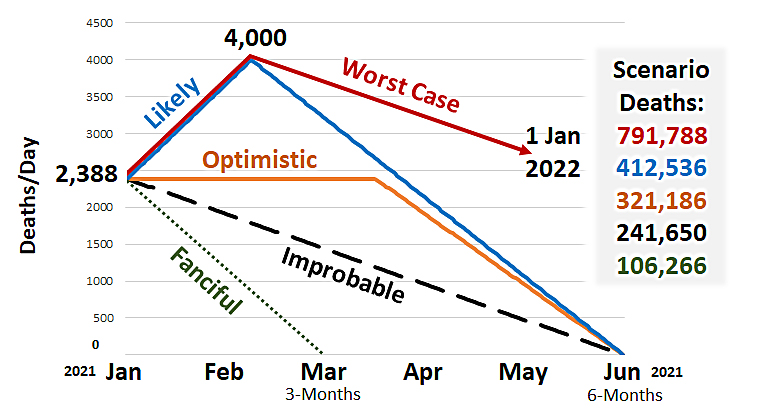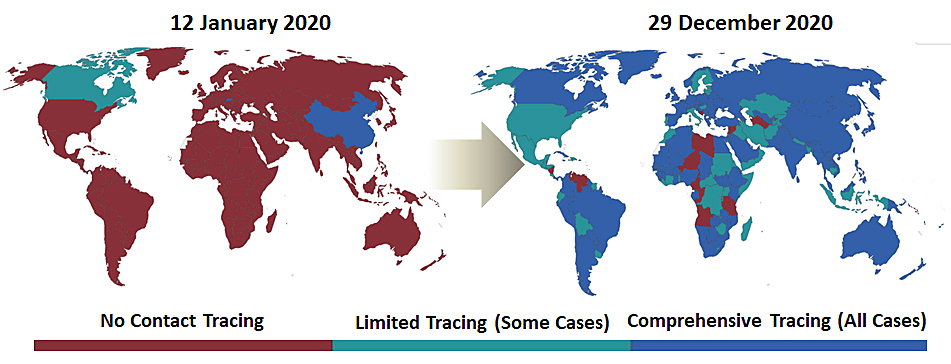COVID 2021
Part I, Scenarios
By: Chuck Vollmer, Jobenomics Founder & President
3 January 2020
The coronavirus could be more destructive in 2021 than in 2020.
Executive Summary
Most Americans are ready to put the pandemic in their rearview mirror and look forward to a new year that will provide a sense of normalcy. Unfortunately, the coronavirus could be more destructive in 2021 than in 2020. COVID-related deaths will not magically disappear with the advent of new vaccines. Unemployment rates and small business closures are likely to increase due to a prolonged economic slowdown. The divide between Wall Street and Main Street will widen due to the Federal Reserve Bank (Fed) stimulus policies that favor making money on money rather than developing human capital. Socioeconomic mobility probably will not significantly improve even with Congressional stimulus packages oriented to short-term aid rather than long-term production of new businesses and careers.
This pandemic provides a unique opportunity to create a more equitable society by giving ordinary citizens the means to be self-sufficient and independent. Congress and the Fed wisely earmarked $2 trillion out of $13 trillion worth of COVID stimulus programs for failing small businesses. These policymakers should allocate an equivalent amount of money ($7 trillion remains uncommitted) to mass-produce locally-owned and operated startup businesses in under-resourced communities. By boosting local ownership, beleaguered neighborhoods will not only prosper economically but reduce homelessness, poverty, crime, and violence.
COVID 2021 Will Continue To Be Deadly
2020 Is Ending With Record-High Coronavirus Deaths
Source: U.S. Centers for Disease Control and Prevention (CDC) Data

COVID Part I claimed the lives of 341,199 Americans in 2020. This Black Swan event is a tragedy that still shocks most Americans who hope for a better new year. The reality is that COVID Part II could be worse in 2021—potentially a lot worse considering a triple-whammy of a higher number of deaths, unemployment, and shuttered businesses. A record-high number of 3,884 one-day COVID deaths occurred on 30 December, less than 48-hours before the advent of the new year. Given the recent upward death rate trajectory, it is reasonable to assume that we will not reach a peak until the January-February timeframe that coincides with the peak flu season.
In 2020, the American public was encouraged to combat the “war” on the coronavirus with the implicit expectation that victory would come soon. Success did not happen when the weather warmed, nor did it occur by year’s end. We were warned to expect a second wave and are now living in the third wave. This new year allows us to make a sober evaluation of the new normal and plan our lives accordingly. It is fanciful to believe that the war will end soon. Even if we are lucky to achieve victory by summer, we still will have to deal with the post-war reconstruction effort of damaged lives and livelihoods.
Jobenomics developed the following visual aid to show possible scenarios, from fanciful to worst case, commencing 2,388 deaths per day, the 7-day rolling average of the last day of 2020 (31 December).
COVID 2021 Scenarios

Fanciful Scenario. Operation Warp Speed produced a score of miracle vaccines in record time. Consequently, many people anticipate a quick end to the U.S. pandemic. If adequately distributed and administered, many people believe that these miracle vaccines can eradicate the pandemic by springtime. Jobenomics considers this scenario improbable, as shown by the dotted green line. Even if this implausible scenario materializes, the United States would still lose 106,266 Americans to COVID-19 by March 2021
Improbable Scenario. The “Improbable” scenario (dashed black line) assumes a positive response to vaccinations and steadily eradicates the virus within six months. If this hypothesis happens, the COVID grim reaper would claim 241,650 people by June 2021.
Optimistic Scenario. This scenario (orange line) speculates a relative constant death rate (2,388) for 90-days until mass immunizations subdue the coronavirus in the subsequent 90-days. This scenario would claim a total of 321,186 fatalities—roughly equivalent to the number of 2020 COVID-19 victims.
Note: Herd immunity could make the Fanciful, Improbable, and Optimistic scenarios a reality.
- Herd immunity occurs when a large portion of a community (the herd) becomes immune to a disease, making it less contagious. There are two ways to generate COVID-19 herd immunity— infection and vaccines.
- World Health Organization data suggests that 80% of COVID-19 infections are mild or asymptomatic. The American Medical estimates that 10-times more infections occurred than the number of reported COVID-19 cases. As of 1 January 2021, CDC reports 19,663,976 reported cases. Consequently, over half of all Americans could be naturally immune, as predicted by the 6 August 2020 Jobenomics Grim Reaper Report. Per the report, “Jobenomics believes that the coronavirus will eventually infect as many as half of all Americans (180 million citizens), but the majority will experience no or only minor symptoms.”
- Vaccines stimulate the body’s production of antibodies and provide immunity against a disease without causing the disease itself in the treatment. Infections create natural immunity via the possession of suitable antibodies to fight the infection. Infectious disease experts at The Johns Hopkins University explain that about 70% of the population needs to be resistant to this coronavirus before herd immunity can work.
- Two vaccines (Pfizer/BioNTech and Moderna) have entered the U.S. market with three more in Phase 3 clinical trials (AstraZeneca, Janssen, and Novavax). Several billion mRNA doses should be available in 2021. Both vaccines claim to be more than 90% effective against coronavirus.
- Messenger RNA (mRNA) is a new type of genetically encoded vaccine. mRNA vaccines that do not use a weakened or inactivated virus that causes COVID-19. mRNA vaccines deliver the genetic instructions for our cells to make viral or bacterial proteins. Our immune system responds to these proteins and develops the tools to react to COVID-19 infections.
- The United States could conceivably achieve herd immunity by Q2 2021 if, combined with previously infected and immune individuals, mRNA vaccines are as effective as advertised, are useful against mutations, and provide a long-lasting defense.
Likely Scenario. According to the U.S. Centers for Disease Control and Prevention (CDC), more than 80,000 Americans could die of Covid-19 over the first three weeks in January 2021, which equates to a rate of 3,809 fatalities per day. The “Likely” scenario (blue line) starts with 2,700 daily deaths, increases by approximately 29 deaths/day for 45 days until reaching 4,000 one-day deaths. After ascending to this peak in mid-February, the vaccines take hold, and the daily death rate decreases by 30 deaths/day for 135 days until the daily death rate is zero. Over these six months, 412,536 Americans would die to COVID-19 in 2021.
Worst Case Scenario. The first four scenarios did not consider the new, more contagious United Kingdom COVID-19 variant found in San Diego County on 30 December 2020. While this variant is not more deadly, it spreads rapidly and demonstrates a vulnerability of our younger population that hitherto experienced low death rates. If one extends the Likely scenario (as shown by the red line) from 180-days to 356-days, an estimated 792,000 Americans would perish.
Putting all this data in perspective, as of 1 January 2021;
- The global pandemic claimed 1.8 million lives out of 7.8 billion people, or 0.02% of the world’s population. Few people grasp that previous pandemics were between 16-times to 110-times more lethal than COVID-19. Here is a list of the deadliest pandemics: 30,000,000 HIV/AIDS deaths (1981-Present); 45,000,000 Spanish Flu deaths (1918-1919); 56,000,000 smallpox deaths (1520); and 200,000,000 Bubonic Plague deaths (1347-1351).
- The U.S. COVID-19 death count reached 341,199, or 0.1% of the U.S. population—a relatively low mortality rate. While 341,199 fatalities equate to 6-times the amount of U.S. Vietnam War battle deaths, this death toll is roughly half the number of annual deaths due to heart disease (647,457) and cancer (599,108). Every life is priceless, but a clearheaded perspective is essential to proper decision-making.
COVID 2021 Suppression Strategy
The Jobenomics team happens to know a great deal about this pandemic. As part of the Jobenomics-Aleph Diagnostics team (https://alephdiagnostics.com/), on 5 March 2020, this author hand-carried the world’s leading COVID-19 antibody rapid point-of-care test kit to the U.S. Centers for Disease Control and Prevention (CDC) in Atlanta and has been involved in combating this virus ever since. With the aid of some of Aleph Diagnostics’ partnerships with leading pharmaceutical firms, our team wrote numerous technical papers on pandemic-related test kits and diagnostic equipment. In August 2020, this author published the widely read “Is COVID-19 the Grim Reaper?” which analyzed the U.S. outbreak and made specific policy recommendations sent to The White House. Jobenomics also produced and televised two hour-long shows on Jobenomics America TV regarding the pandemic and coronavirus suppression strategies.
During COVID 2020, U.S. policymakers and thought-leaders failed to mitigate the coronavirus. The reason for this failure is that a mitigation strategy is not the proper approach to a high-contagious pathogen. Mitigation strategies focus on slowing down transmission but not necessarily stopping the pandemic. Mitigation protocol typically focuses on mask-wearing, social distancing, personal hygiene, limited testing of symptomatic individuals, quarantines, protection of vulnerable groups, and reducing peak healthcare demand. Had the coronavirus followed a seasonal path, like an influenza virus, mitigation might have been the proper U.S. strategy. Unfortunately, this virus is not seasonal, and outbreaks are frequent.
For COVID 2021, America must abandon its reactive mitigation strategy to favor a more proactive suppression strategy that has proven successful in other countries, such as Australia, Singapore, Japan, and China. A suppression strategy involves a comprehensive approach to testing, contact tracing, and supported isolation (TTSI). TTSI programs reduce uncertainty and fear, allowing people to feel freer to resume normal activities while still observing pandemic protocols, like mask-wearing. Suppression-level testing requires large-scale testing, including proactive testing of asymptomatic people (infected individuals who appear healthy) in vulnerable populations (e.g., the elderly) and high-risk environments (e.g., workplaces). The time to implement a proactive suppression strategy is now, before the advent of the flu season. There are plenty of state-of-the-art antibody, molecular, and antigen tests available now to start a nationwide effort.
The biggest obstacle holding back a nationwide suppression-level testing program is a national willingness to do so. We are a divided nation often interested in ideologies rather than our collective prosperity.
Mitigation versus Suppression Strategies
Confirmed Deaths, 7-day Rolling Average, 1/21/2020 to 12/29/2020

Countries like Australia, Saudi Arabia, and China have contained COVID-19 via successful suppression strategies. Of the three, Australia is culturally most like the USA. Unlike the USA, Australia implemented strict suppressions protocols of mass testing (393 tests per confirmed case versus 13 for the USA), contract tracing, and international and domestic travel restrictions, with only a handful of deaths since early November. Additionally, Australians unified their political parties and kept their media from politizing the pandemic and pandering to special interest groups.
A 2021 U.S. suppression strategy starts with accepting that the virus is now so widespread that everyone is vulnerable. Outbreaks and potential hotspots need to be extinguished quickly by massive testing of asymptomatic individuals, aggressive contact tracing, and supervised/supported isolation. Now that vaccines are available, suppression protocols must balance inoculations with routine testing. The current portfolio of vaccines advertise 95% effectivity but may protect for only a relatively short time (months rather than years or decades like the measles and polio vaccines). Moreover, a sizable percentage of Americans will not submit to vaccinations for a multitude of justifiable reasons. Thus, rapid point-of-care and self-testing will be extremely important not only to ensure that the vaccination is still potent and providing a way for anti-vaxxers to prove that they are virus-free. It is also important to note that coronavirus testing may not be a one-time test. Multiple tests will be required to ensure immunity and quell hotspots.
Anyone who comes into close contact (e.g., within 6-feet per social distancing recommendations) with a COVID-19 person is at risk of becoming infected themselves and others. Contact tracing helps prevent further transmission of the virus by quickly identifying and informing people who may be contagious, so they can take steps not to infect others. Unfortunately, the U.S. contact tracing efforts are underperforming in comparison with other countries. The only way to implement a more robust contact tracing program is to associate it with a suppression-level TTSI program, as discussed earlier.
COVID-19 Contact Tracing by Country
Source: Oxford University, Our World in Data.org [1]

These two maps (January and August 2020) depict the status of contact tracing programs worldwide.
- As of 12 January 2020, only China and Slovakia (a Chinese ally) had comprehensive COVID-19 contact tracing programs. The country with limited tracing was Canada.
- As of 29 December 2020, most of the world has comprehensive COVID-19 contact tracing programs. The United States has not yet implemented a viable program since policymakers believe that a comprehensive vaccination program will eradicate the virus and make a suppression-level TTSI program moot.
Mass screening and contract tracing are critical tools in opening and restoring local, state, and national economies. New Delhi (India) conducted a large-scale screening effort in July 2020 for its entire population (29 million) to suppress hotspots across the metropolitan area. During a June 2020 outbreak in Wuhan, the Chinese tested the whole population (11 million) in 10 days. Considering the recent upturn of infections in the USA, government officials would be wise to adopt similar procedures until we achieve herd immunity.
Part II deals with COVID 2021’s impact on the U.S. economy and labor force. The anticipated posting date is 11 January after the Bureau of Labor Statistics data is available for the calendar year 2020.
[1] University of Oxford, Oxford Martin Programme on Global Development, Our World in Data.org, Which countries do COVID-19 contact tracing? 2 August 2020, https://ourworldindata.org/grapher/covid-contact-tracing?year=2020-01-12



